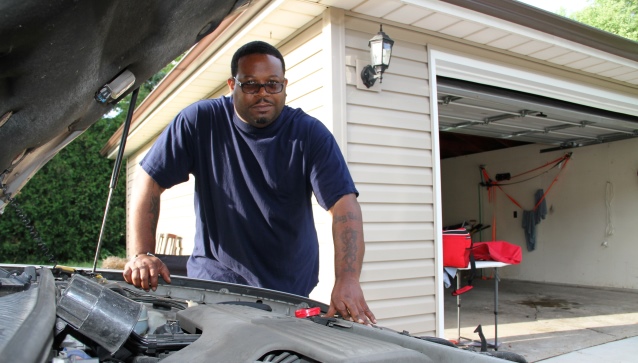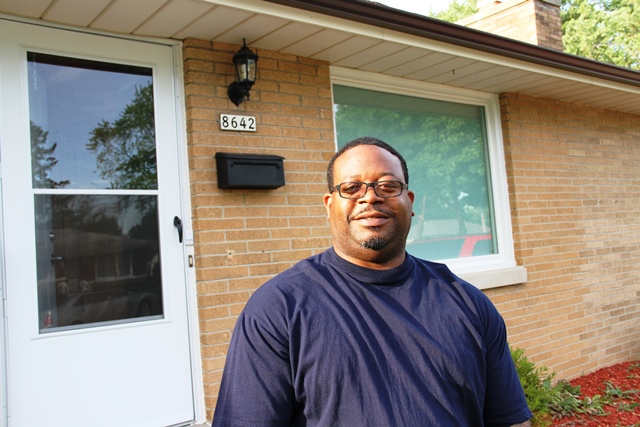 |
|||||||||||||||
|
|
20th ANNIVERSARY |
||||||||||||||
|
|||||||||||||||
John Barbosa's journey to becoming a homeowner started with a bill. "I was living at Parklawn at the time, and there was a leaflet about homeownership in with my rent receipt," says Barbosa. "It wasn't something that I had really thought about before. I wasn't really familiar with the process of buying a home and I really never thought I could be a homeowner." Barbosa wanted to know more, and ultimately became one of the 185 successful participants in the Housing Authority of the City of Milwaukee's Section 32 program, which assists public housing or public housing-eligible residents in purchasing homes. "I went out and looked at a few homes that the City of Milwaukee had for sale as well as those listed by Realtors," he said. "It was probably five homes, which was quite a process." Ultimately, Barbosa ended up purchasing a ranch home on Milwaukee's northwest side. "I had a really good experience as a resident of Parklawn, but I just love being a homeowner," he says. "I've been in my home for four months now, and I just love the peace and quiet. This is a great neighborhood, too." HACM's Section 32 program is the original component to a comprehensive housing program now celebrating its 20th year of serving qualifying low-income city of Milwaukee residents. During that time, the entire homeownership program has facilitated the sale of 483 properties and helped to added an estimated $6,000,000 to Milwaukee's tax base. "These programs offer a variety of means for low-income residents to achieve a very real goal: Homeownership," says Tony Pérez, HACM secretary-executive director. "As this program reaches its 20-year milestone, we can see how it has improved many of Milwaukee's neighborhoods, one new sale and one new proud homeowner at a time." |
|||||||||||||||
 John Barbosa's new home has its own garage and space for working on his car. |
|||||||||||||||
HIGH QUALITY, MOVE-IN READY HOMES While interested purchasers can look at homes placed on the market by Realtors, as Barbosa did, they might also consider purchasing a tax-foreclosed home. The City of Milwaukee's Neighborhood Stabilization Program has provided funds for HACM to acquire, rehab and sell 13 tax-foreclosed properties. Twelve of these homes have sold to date, and the proceeds are used to acquire, rehab and sell additional foreclosures. "HACM acquires the homes for this program from the City of Milwaukee's foreclosure list," explains Dario Romero, manager of the Section 32 program for HACM residents. "These homes are usually in need of extensive rehab work, from new mechanicals to windows and flooring." Jim Eigenberger, HACM's senior asset manager who oversees the Homeownership Program, notes that once these homes are rehabbed, they are in move-in condition. "There is really nothing that needs to be done to them, which is great for a first-time homebuyer - there's nothing that needs to be fixed or updated," he says. "Many of these homes were also extremely well built originally, and HACM tries to keep the original materials if possible. Depending on the home, it's entirely possible to find leaded windows and original woodwork." EDUCATION, CASE MANAGEMENT AND FINANCIAL ASSISTANCE If a client purchases a HACM-owned home, they may qualify for up to $25,000 toward its purchase, which is a forgivable second mortgage. But the program provides much more than financial assistance: Participants learn how to be successful homeowners. The program's required homeownership counseling component includes HUD-approved classwork and credit counseling, which must be completed before potential homeowners talk to lenders. "The majority of our buyers are Housing Authority residents," says Romero. "These buyers are usually very motivated and have worked hard to reach their goal. The process to become a homebuyer can take years - they have to work on building their credit history and saving for possible closing expenses associated with purchasing a home." This process has resulted in a program with very low foreclosure rates. "Right now it is less than 8 percent," says Eigenberger. "That's lower than homeowners who purchase through traditional means." "We don't want to set people up to fail," says Jeanne Dawson, manager of the Section 32 program for non-HACM residents. "And beyond that, this program also often brings homeowners a few blocks closer to where they want to live." For example, Dawson is currently working with a family that received a maximum loan approval of $65,000. With the Section 32 program, the family is now able to look at homes up to $90,000, which opens up new blocks and new neighborhoods for consideration. "The end result is that this family is now purchasing a really nice ranch home in a stable neighborhood that fits their needs perfectly," she says. "Without this program, they would have been much more limited in what homes they could consider." Since 2000, the Housing Authority has also offered a second program, the Section 8(y) program, open only to those people receiving rent assistance. It provides a monthly subsidy for homeownership costs, 15 years for a 20-year mortgage for homeowners who are not elderly or disabled, and a perpetual subsidy for elderly or disabled homeowners as long as they own the home. Housing Authority clients come to this program after receiving a voucher. "I have seen, in most cases, that the client's portion of the mortgage, as well as the HACM subsidy portion, is lower for a home than it is for a rental," says Carol Schmidt, manager of the Section 8(y) program. "Like the Section 32 program, participants in the Section 8(y) program are guided into becoming solid homeowners. "I like that we walk them through the process," says Schmidt, who maintains a bulletin board of program information and available homes for clients. "If an applicant is eligible, he or she is invited to an orientation. We discuss the program details, go over terms they will hear and steps they will take as they transition to home ownership, as well as the people they will work with in the process." Schmidt and the other staff discuss the pros and cons of home ownership with participants, as this is usually a first-time experience for them. Participants then attend required HUD coursework and credit counseling. As the participants progress through the program, staff stay in contact with all involved parties, including the lendor, Realtor, and inspector. The entire HACM Homeownership team also is involved in marketing newly constructed homes in the Highland Gardens neighborhood, a new urban subdivision created just north of downtown. Homes built in this neighborhood are built using energy-efficient principles and components. "These have been hugely successful programs," says Eigenberger. "It is a win-win situation: HACM residents and qualifying non-residents become homeowners, which adds properties back to the tax rolls. These are people who want to be homeowners and take pride in their homes, which helps stabilize Milwaukee neighborhoods." LEARN MORE: 20 years later, this home is still a family's foundation
|
|||||||||||||||
| . | |||||||||||||||
| The Housing Authority of the City of Milwaukee is an equal opportunity housing provider and does not discriminate on the basis of race, color, religion, national origin, ancestry, sex, age, handicap, lawful source of income, marital status, family status or sexual orientation. | |||||||||||||||
